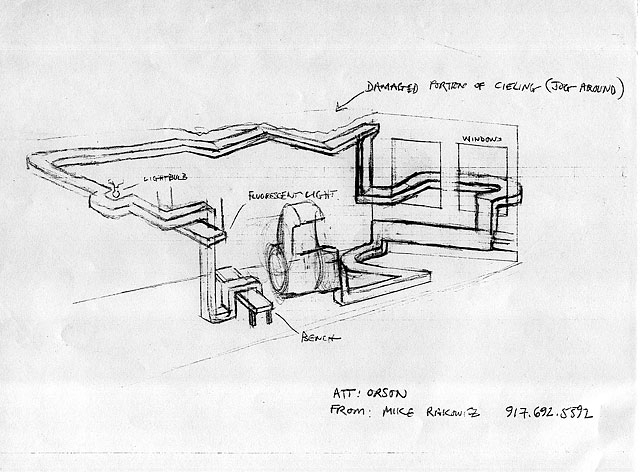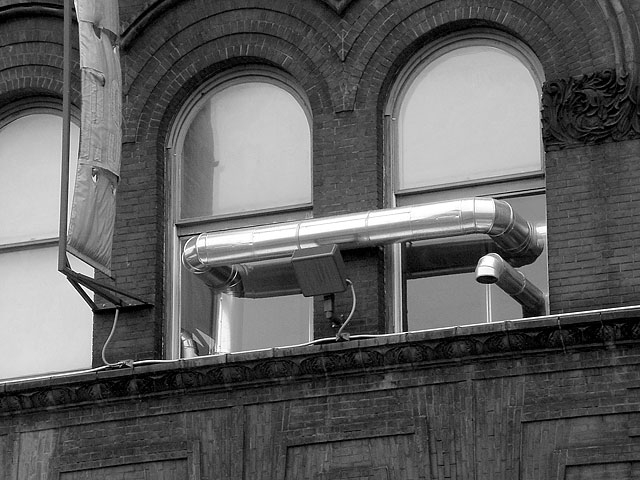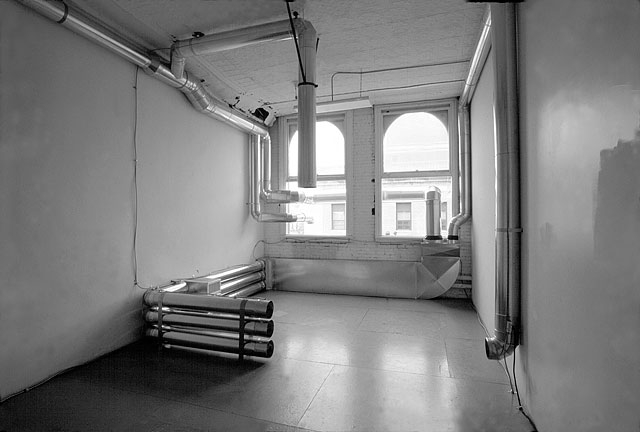
Most museums and exhibition spaces have a central climate control system for maintaining the standard temperature and relative humidity (r.h.) necessary to preserve art works on exhibit. P.S.1 Contemporary Art Center lacks such a mechanism and, during the winter, turns its radiators up to 90˚ F, ignoring the institutional standard of 68˚ - 72˚ F. The dry heat of the radiators engenders a relative humidity reading of approximately 11%, potentially damaging to objects like paintings or prints, which require stabilized environments of between 40% - 50% r.h.

In order to lower the temperature of the Special Projects room to which it is confined, Climate Control, an apparatus consisting of ductwork and fans, incorporates the existing radiator system on the interior of the building with the cold winter temperature outside. The resulting maze of ductwork features a central absurd element: the continuous duct which travels outside the windows and then directly back in, visible from the street. An internal humidifier feeds off moisture in the air and maintains a relative humidity of 20%, in keeping with the standard for exhibiting artworks made from galvanized steel. While the system is adjustable and can maintain a stabilized environment for the display of even delicate works on paper, there is no space to exhibit other art: Climate Control completely engulfs the room. The result is an absurd machine built to maintain itself.




Most museums and exhibition spaces have a central climate control system for maintaining the standard temperature and relative humidity (r.h.) necessary to preserve art works on exhibit. P.S.1 Contemporary Art Center lacks such a mechanism and, during the winter, turns its radiators up to 90˚ F, ignoring the institutional standard of 68˚ - 72˚ F. The dry heat of the radiators engenders a relative humidity reading of approximately 11%, potentially damaging to objects like paintings or prints, which require stabilized environments of between 40% - 50% r.h.
In order to lower the temperature of the Special Projects room to which it is confined, Climate Control, an apparatus consisting of ductwork and fans, incorporates the existing radiator system on the interior of the building with the cold winter temperature outside. The resulting maze of ductwork features a central absurd element: the continuous duct which travels outside the windows and then directly back in, visible from the street. An internal humidifier feeds off moisture in the air and maintains a relative humidity of 20%, in keeping with the standard for exhibiting artworks made from galvanized steel. While the system is adjustable and can maintain a stabilized environment for the display of even delicate works on paper, there is no space to exhibit other art: Climate Control completely engulfs the room. The result is an absurd machine built to maintain itself.